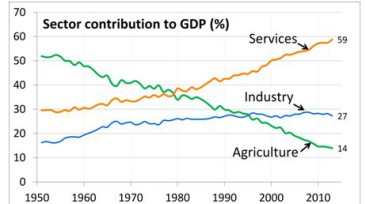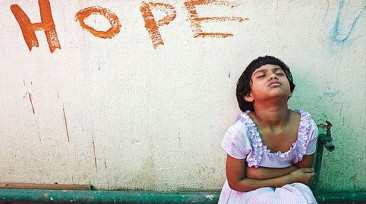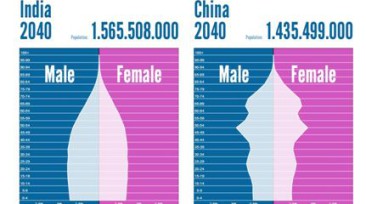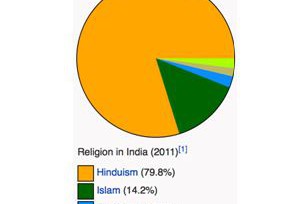2016: The Year of India… And the Last Chance for an Organized Systemic Global Transition
BRICS, 30 Nov 2015
Global European Anticipation Bulletin-GEAB – TRANSCEND Media Service
When LEAP launched the GEAB in January 2006 with the object of describing a “global systemic crisis” in the making, one of its aims was to help raise awareness amongst Europeans of the US’ weakness and of the opportunity which then existed to complete the continent’s independence process. This objective was not only motivated by a purely European interest, it was based on a strong prediction that we often repeated here: the transition of a Western centred world towards a multi-polar one would go very badly if Europe was unable to extricate itself from the Western camp in which a “hard-line America” shut it. Indeed, combined with Europe, this America had no further reason to question itself and could implement a pure power strategy to try and keep its global leadership.
American Judo Hold on Europe
We have thus begun to identify and analyze all the signals of Europe’s attempts to gain independence for almost 10 years. Sadly, despite some worthy genuine attempts, Europe didn’t sufficiently seize the opportunity of the half decade from 2008 to 2013 (in particular the choice of a black president to lead the US lulled it to sleep).
A weakened US needed Europe’s force to maintain its supremacy; the control of this force was there for the taking since the EU had “omitted” to do what was necessary to anchor its political legitimacy; and since the spot was already occupied, European “insouciance” did the rest. In 2014 the US put a true judo hold on Europe, turning European force against itself and blocking our continent.
Since the Ukrainian crisis and despite the relative “freezing” of the situation linked to the Euro-Russian Minsk agreements, the bad news on Europe piles up: non-resolution of the Greek crisis, disastrous elections in Poland[1], deployment of US troops on various parts of the continent, blocking of the Euro exchange rate at near parity with the dollar[2], disruptive waves of immigration, support of the anti-change political forces at the head of a completely disrupted UK, European inability to implement the measures imposed by the huge crisis, aggressive takeovers of the European economy’s flagships by US businesses[3], etc. The more the world frees itself of the US, the more the US hand tightens around the European neck.
Thus Europe finds itself dragged into the crazy strategy of a hard-line America: attack the multi-polar world from all directions… of which Europe was, of course, potentially iconic. Russia eliminated from the international game thanks to the Ukraine; China eliminated from the international monetary and financial system thanks to the IMF rejection to include the Yuan in the SDR[4] ; Brazil reduced to the rank of speculative borrowers by the US rating agencies[5]…
Of course, the crisis itself undermines everyone «naturally », but malicious action is now so visible that we can’t ignore it without sinking into naivety: the world is bad enough so that acts of intransigence and non-cooperation can’t be interpreted other than the result of a deliberate wish that things should get even worse… for anything that isn’t American. As we have strongly emphasized throughout the first half of 2015, the solutions and cooperation to introduce around the crisis are henceforth sufficiently obvious so that the acts consistent with hijacking them cannot be anything other than malicious.
India to the World’s Rescue: Convergence of Characteristics
That said, we still see a last chance for the world to stay on the path of a non-destructive organized transition; and that chance is India.
We believe that India should profit from a window of opportunity in 2016 which would enable it to be a positive catalyst in the transition towards a multi-polar world. The central argument is as follows: in 2016 India will combine the characteristics which should enable it to interconnect with two other “major” BRICS – Russia and China – and tip the scales towards a multi-polar world irresistible to Western eyes, with Europe in the front row.
These characteristics are as follows:
. Demographics: it is generally accepted that India will surpass China in population size by 2030, perhaps even earlier[6]. As an anticipatory effect, India is therefore upgrading on a not insignificant point (demographic size) with the world number one in this area. This simple fact is in a position to help the West better understand this notion of a multi-polar world which it currently seems to be incapable of imagining, preferring to focus on the prospect of replacing US leadership by a less familiar Chinese one.
. Youth and dynamism: unlike its two neighbours to the East and West, India displays the energy and youth of its society[7], a dynamic and innovative youth that necessarily attracts sympathy, an optimistic social fabric and visibly the bearer of an irresistible future for the world economic players.
. A consumer society: here, where it still only a goal for China, India already has an economic model oriented towards domestic consumption[8] and the emergence of an already well represented middle class; it’s a strong asset for stability and the guarantee of greater independence for the country.
. Connection to the world: Indian society, particularly through its vast global diaspora[9] but also because of its expertise in new technologies[10], is very well connected to the world, a world which it understands better since its deepest domestic diversity doesn’t make it see the rest of the world as something very complex. Here again there is a marked difference with China particularly, and with Russia to a lesser extent, two countries which relatively recently emerged from the confinement that we saw.
. Service economy: if Russia’s wealth makes it depend on highly conflicting energy and raw material international markets and if Chinese industrial power still heavily depends on its ability to export to the major overseas consumer markets, India completes the threesome with its service economy[11], more flexible and modern and certainly less dependent on the exterior.

Figure 2 – Contribution of services, industry and agriculture to the Indian economy, 1951 – 2013. Source: Wikipedia
. Religious diversity: in this multi-polar world which must reinvent religion’ s place in society as Malraux[12] anticipated, India’s religious diversity makes this country a valuable asset in solving the huge tensions in this area. The major question of Islam’s place in the 21st century world may find a source of understanding and resolution in the Indian model of religious tolerance[13].
. Democracy: here, India enjoys a positive image according to Western standards. Often called “the largest democracy in the world” (in size) by Westerners themselves[14], the imperfections of the Indian political system are easily excused given the difficulty of carrying out the democratic process in such a complex country
. Strong leadership: Narenda Modi’s « tidal wave” victory last year[15] favoured India with a very strong leadership which allows it to take important decisions and carry out the changes necessary for the country and beyond. Modi has a real can-do attitude… perhaps more than anyone else in the world today.
. Independence: several previous characteristics have shown that India has a good potential for independence. The nationalism displayed by Modi is a further guarantee that his can-do attitude is well placed to serve his country’s interests, interests that can’t exist without a balance with foreign powers. In fact, we see that Modi maintains good relations with the US (putting into practice the partnership agreement with the U.S. Army[16]) whilst asserting that it must improve those with China[17] (“you can’t choose your neighbours”)…
. Positive international image: the absence of a Communist past, the history of the country’s terrible suffering under British colonization, the heroic character of a peaceful independence process, the memory of the great political leader Gandhi… and even still the country’s “third-world” image are just so many factors that make any undermining of the country’s image abroad difficult, especially in Europe.
. BRICS Presidency: finally, and this isn’t just a detail, India will chair the BR ICS in 2016[18], which will make cooperation with Russia and China particularly a state priority and create the conditions for further increased rapprochement. Modi’s exceptional activity internationally[19] is unlikely to diminish with the responsibility for an agenda of a global nature related to this Presidency.
This list of characteristics converges in an indication of a strengthened international role for India in 2016, with the strong potential of building on India’s positive image, a positive image for the BRICS and, therefore, for the multi-polar world and blow away all the reservations associated with this development in the West’s eyes.
That said our team prefers not to express any anticipation on the final outcome related to this potential. Instead we anticipate that because of this potential, India will experience unexpected difficulties in the next few months, even weeks.
The players or apparatus programmed to prevent this transition will certainly make the same analysis as us and are undoubtedly taking steps already to weaken India. And, in fact, looking more closely, the problems which have surprisingly saved Modi since the beginning of his term of office are starting to appear. Here are two examples:
- the strange revolt by the Patels[20], a middle-class caste which has violently attacked Modi’s policies in recent weeks and has the characteristic of being the largest represented caste in the US[21];
- this article which begins to set the tone of the attacks of which Modi will be the target in the coming months: India on the way to a constitutional dictatorship. The fact is that our team is surprised that the new Indian Prime Minister’s “skeletons” as regards managing ethnic conflicts[22] haven’t yet appeared. In its own good time…
We expect that the Indian BRICS Presidency will take place in a context of major political tensions over India which could reduce the excellent convergence of traditional advantages presented by India in 2016 to nothing.
If India is pushed to failure on this point, then the prospects will be irreparably dark for the transition path that the world must take and which will correspond to the to the second of two narratives on the future by Franck Biancheri in 2010 in his book «The World Crisis : The Path to the World Afterwards», a “tragic Twilight”…
—————————————————–
NOTES:
[1] The “unexpected” result of the last Polish elections in favour of the very anti-European and pro-NATO Duda, already commented upon in the last GEAB issue.
[2] For several months now, the Euro has been unable to rise above 1.12 to the dollar… whatever the news: good news on the economy, Chinese sale of dollars, etc.
[3] For example: recent revelations about what lies behind Alstom’s takeover by GE (which, moreover, has just confirmed all the GEAB’S analyses on the subject). Source : France Inter, 10/09/2015
[4] Source : Wall Street Journal, 19/08/2015
[5] Source : The Guardian, 10/09/2015
[6] Source : Deutsche Welle, 04/09/2015.
[7] Source : Economic Times of India, 18/11/2014.
[8] Source : Economic Times of India, 24/08/2015
[9] Source : Indian Diaspora
[10] Source : Economic Times of India, 28/07/2014
[12] It would seem that Malraux never actually spoke his famous phrase: “the 21st-century will be spiritual or will not be”, but rather this one, more explicit and visionary: “I think that the task for the next century, in the face of the most terrible menace that humanity has known, is going to be reinstating the gods”. Source : Wikipedia
[13] By chance, our team has come across this video which says much about India’s potential in terms of positive integration through religion and its social diversity.
[14] For example, on the European Parliament site. Source : Parlement européen
[15] Source : The Telegraph, 16/05/2014
[16] Source : Reuters, 14/07/2015.
[17] Source : Quartz, 15/05/2015.
[18] Source : lainfo, 09/07/2015
[20] Source : New York Times, 07/09/2015
[21] See the « Patel Motel phenomenon». Source : Wikipedia
[22] Source : New York Times, 19/08/2015.
DISCLAIMER: The statements, views and opinions expressed in pieces republished here are solely those of the authors and do not necessarily represent those of TMS. In accordance with title 17 U.S.C. section 107, this material is distributed without profit to those who have expressed a prior interest in receiving the included information for research and educational purposes. TMS has no affiliation whatsoever with the originator of this article nor is TMS endorsed or sponsored by the originator. “GO TO ORIGINAL” links are provided as a convenience to our readers and allow for verification of authenticity. However, as originating pages are often updated by their originating host sites, the versions posted may not match the versions our readers view when clicking the “GO TO ORIGINAL” links. This site contains copyrighted material the use of which has not always been specifically authorized by the copyright owner. We are making such material available in our efforts to advance understanding of environmental, political, human rights, economic, democracy, scientific, and social justice issues, etc. We believe this constitutes a ‘fair use’ of any such copyrighted material as provided for in section 107 of the US Copyright Law. In accordance with Title 17 U.S.C. Section 107, the material on this site is distributed without profit to those who have expressed a prior interest in receiving the included information for research and educational purposes. For more information go to: http://www.law.cornell.edu/uscode/17/107.shtml. If you wish to use copyrighted material from this site for purposes of your own that go beyond ‘fair use’, you must obtain permission from the copyright owner.



What india could emerge as the author imagine is only the half truth. The author has missed to see how the current Indian administration has been intolerance to the religious minority but also to the media critics, and to the charitable organizations other than Hindu. Indian Prime Minister Narendra Modi has drastically failed in opening the economy for the fast development.
I find this list, apparently pleasing to the author and praised in the statements, a frightening prospect for any country and one to be avoided if possible, not accepted.
According to Arundhati Roy, who care about the have-nots,
India has more poor people than sub-Saharan Africa, has millions of displaced, persecuted peoples, many uneducated. Sixty million “middle class” inhabitants is great for them, but the vast majority are certainly not cared for, and democracy is just a word and a vote-what happens then?